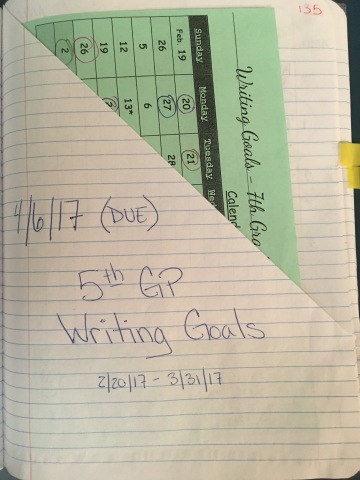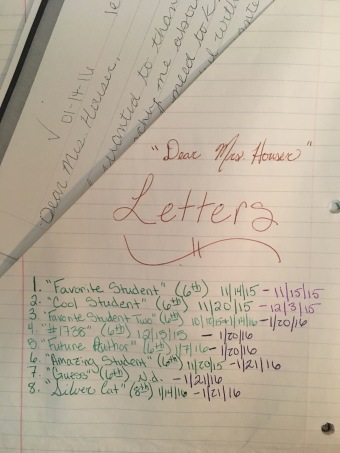Teaching writing to middle school students has taught me many things, but one lesson screams the loudest: writer’s need to write.
![IMG_5283[1]](https://jjburry.com/wp-content/uploads/2017/06/img_52831-e1498768495995.jpg?w=301)
I already knew this, right? I’m also a writer, so I had to already have known this. Of course I did, but it was never more true for me as a writer as it is now that I’m a writing teacher.
The one thing that writers need (whether they are students or not) is the freedom to write. This is where writer’s notebooks come in. They offer that freedom and so much more.
What is a writer’s notebook?
A writer’s notebook is a blank book waiting for a chance to hold your imagination within its pages. It can come in many different styles and can serve many different purposes. Some writers decide to have multiple notebooks: each serving a separate purpose.
For students and writers alike, a writer’s notebook offers a sort of playground for the mind.
- Store your ideas
- Build on your ideas
- Collect new ideas and mentor pieces
- Learn and practice new skills
- Play with ideas
- Model proper writing for others
A writer’s notebook is not a journal or diary. Diaries are a great place to look for ideas to add to your writer’s notebook, but it’s important to know that they’re not the same thing. Those are for writing about your day, usually in the order it happens. Writer’s notebooks are not as neatly organized: they tend to be quite chaotic.
How do I start a writer’s notebook?
Do you want to start a writer’s notebook? Are you wondering where to start? Before I give you my seven steps for starting your own, let me tell you something first: there is not only one way to start one or keep one. These are the steps I use and the steps I teach my students:
- Choose your purpose
- Why are you starting this notebook? Is it for poetry, a novel you’re working on, a collection of ideas, or something else?
- Click here for the Classroom Version of setting up your Writer’s Notebook!
- Determining your purpose can help you decide what kind of notebook to get.
- Choose a notebook
- Maybe you want a smaller notebook for poetry, or a larger one for your novel, or something that is durable to hold all of your ideas.
- Look around at different stores and figure out what will work for you. There are spirals (I don’t recommend since they fall apart easily), composition notebooks (my students use these), and many other options (I’m currently using a hardcover journal).

- Take ownership of it: Decorate!!
- This is probably the most important step. This is the personalization step: make it yours. Why? You are more inclined to write in it if you feel a personal connection to it.
- One way you can do this is to decorate it (which is what you see in the photo above – and which I ask of my students to differentiate their notebooks in class).
- Create an “Idea Pocket”
- This is a pocket in the back that you can use to store clippings until you use them.

- This is a pocket in the back that you can use to store clippings until you use them.
- Create an index
- An index will help you in the future when you are hunting down an idea you had in the past.
- I’m reformatting the index we use in our notebooks in class in order to incorporate a modified version of the “Bucket System” by Jeff Goins.
- An index is in the back of your notebook and works from the last page forward. In my opinion it is better than a table of contents because you do not have to save any pages; therefore, you will not waste any space.

- Create writing goals
- Writing goals – these change so often that we’re never sure what our current goal is, right? That’s not true. You should create achievable writing goals every so often (weekly, monthly, etc.) in order to achieve whatever writing tasks you have set for yourself.
- Setting goals also comes with reflections. There is no point in setting the same unachieved goal three times in a row. What will change this time? Reflect on why it wasn’t achieved after the first time, and rework it to incorporate a plan of action.
- I keep writing goals alongside my students. They need to know that the work they have to do is important – what better way of proving that than to show them?

- Start writing!
- Self-explanatory!
“Your writer’s notebook needs to become a personal source of pride to you…” -Corbett Harrison
Wait! Start writing what?
Your notebook is ready to be written in, staring at you helplessly empty. Hundreds of pages worth of empty. Hundreds.
Are you feeling a bit overwhelmed now? Don’t worry. This is where the goals you set earlier come in handy. Maybe you set goals that included collecting ideas (start by filling up Bucket 1- the idea bucket)…
Maybe you were hoping to learn a few new words or write some letters… I encourage my students to write letters to me in their writer’s notebooks, especially when they are struggling with a skill, and I always answer them back.

The letters not only encourage handwriting and formatting skills, but they also encourage writing for a real-life purpose. I keep a copy of their letters in pockets of about eight in order to answer them when I have a chance.
A copy of the answer is made for them personally. I also keep a document in Google Classroom that displays each letter I write back. This allows them to read the answers, which could help with skills they too want help with.

As you can see on the pocket and photo above, the best part of the letters for my students is that they get to choose their own pen names (again, a real-world experience).
Letters are an amazing tool because they can be used to write out your ideas or incorporate stories. We’ve used letters to write to characters, too. Have you, as a writer, written to your MC (main character) or from your MC’s point of view? That can supply a whole slew of information for you!

Whatever your idea is, create it! Build up Bucket 1 with charts, lists of your favorites (songs, books, movies, etc.), newspaper clippings, questions, research, etc. From there you can take your writing anywhere. Use those ideas as inspiration and continue on your writing journey!
What do I do when it’s full?
You’ve filled your writer’s notebook? First, let me say: “Congratulations!” You should also congratulate yourself for all the writing you’ve accomplished.
Be sure to keep this notebook since it is not only filled with ideas you’ve used, but it’s also filled with ideas you could pursue in the future. Every now and then, take it out and reread it. See if a new idea is sparked.
Before you start a new notebook, take time to reflect. Did this notebook serve its intended purpose? Why or why not? What could you do differently with your next one?
Based on your answers, you may end up choosing something a bit different next time! Start hunting for your next notebook now, and have another wonderful adventure writing!
Resources
Writer’s Notebooks – Corbett Harrison
Article about the purpose of a Writer’s Notebook in the Classroom
Writing ideas – Ralph Fletcher
Writing prompts – Writer’s Digest
Heinemann Writing Strategies Book (page 118 idea used above)





![IMG_5284[1] IMG_5284[1]](https://i0.wp.com/jjburry.com/wp-content/uploads/2017/06/img_52841.jpg?w=406&h=406&crop=1&ssl=1)




This is great! There are a lot of solid ideas in here. I definitely like the idea pocket and goal setting. I will have to work that into my Notebook this year, especially with my students.
LikeLiked by 1 person
Thank you! I’m still working on the goal-setting… I still haven’t found a way that works for me yet.
LikeLike
Hi Jessica,
I came across your blog from the 10 Minute Novelists FB group. Loving your suggestions, ideas and resources that you provide. I’ve heard of a writers notebook but never used one. Like Patricia mentioned above, I have a habit of not wanting to mess up a new book or journal.
I like the idea of creating a writers notebook from scrapbooking supplies. I have tons of that around, so I may make one for myself.
Thank you again for all of your tips and ideas.
LikeLiked by 1 person
Thank you for your comment! I love to “mess up” a new notebook… Is that weird?
I hope you put your supplies to good use and create an exciting new notebook! It’s fun to figure out what to put on the first page, too.
I do love the 10 Minute Novelists FB group! I’m glad you found me on there. 🙂
LikeLike
Great post. I consider Evernote my “Writer’s Notebook.” I save pictures and prompts from websites. I have “notebooks” for different things like blog topics, short story ideas, and my big project. But I do like the idea of having a physical notebook with stuff like an index. I guess the one thing that holds me back from getting one is that I’m afraid of personalizing it. I want it to be nice all the time; I wouldn’t know how to make it my own. And I’m so used to having lined notebooks, I’d be so anal about keeping text linear and proper. But maybe that’s what I need to allow myself to be free.
LikeLiked by 1 person
I didn’t consider digital notebooks! Excellent!
Personalizing it isn’t scary- it’s freeing. You can do this any way you want. I use scrapbook paper, which comes in all sorts of colors and designs!
As far as using the lines, it depends what you’re writing. The lines offer comfort to most writers, but they also offer rules to break. Who knew it’d be so much fun not writing on the lines?
I definitely suggest trying a tangible notebook, but your digital one is a great idea, too!
LikeLike
What do you mean by “tangible notebook?”
LikeLiked by 1 person
Handheld for writing by hand.
LikeLike
Kind of like what you suggested in your post. Composition books. Hardcover books. That kind of thing.
LikeLiked by 1 person
Exactly like that!
LikeLike
Knowing me, I’d get a notebook to try this then not want to write in the notebook because it’s so pretty and new! LOL
LikeLiked by 1 person
Thanks! Pretty and new, but still waiting for all of your ideas!
LikeLike
Great post! I love how much fun you have with the art. That definitely personalizes the notebook and makes it seem less intimidating. Pockets are a cool idea I’d never thought of.
LikeLiked by 1 person
Thank you for your comment! Pockets have been a lifesaver for sure.
LikeLike
Nice! I keep two notebooks. A smaller one for my poetry and a larger one for my prose. I’m still considering going down to using the large one for everything, to make it more convenient. When my notebooks are full, I type up the stuff I want to keep and then burn it. There’s a strange catharsis about it.
LikeLiked by 1 person
You burn it! Eek! I’m not sure I could do that- there are too many ideas in there to burn. I never know when I might use one.
I know several people who keep more than one notebook (especially poets). I personally like having everything in one place.
LikeLiked by 1 person